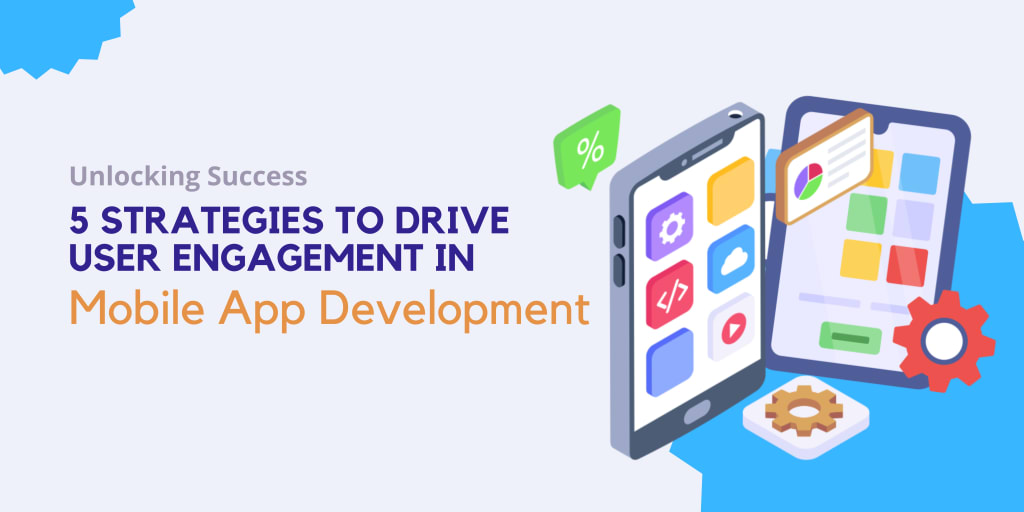Unlocking Success: 5 Strategies to Drive User Engagement in Mobile App Development
Unlock Success In Mobile App Development

In today's digital age, mobile apps have become an integral part of our lives. With millions of apps available in the app stores, how can you ensure that your app stands out from the competition and drives user engagement? Unlocking success in mobile app development requires a strategic approach that combines innovative design, seamless user experience, and effective marketing strategies. In this article, we will explore five proven strategies that can help you drive user engagement and propel your app to new heights. From creating a captivating onboarding experience to implementing personalized push notifications, we will uncover the secrets to keeping your users hooked and coming back for more. So, whether you're a seasoned app developer or just starting out, buckle up and get ready to unlock the true potential of your mobile app with these five game-changing strategies.
The Importance of User Engagement in Mobile App Development
User engagement is the lifeblood of any successful mobile app. It refers to the level of interaction and involvement users have with your app. High user engagement not only leads to increased app downloads but also drives customer retention and revenue growth. When users are engaged, they spend more time using your app, share it with others, and even make in-app purchases. To put it simply, user engagement is the key to unlocking the success of your mobile app.
Understanding the User Journey
Before we dive into the strategies, it's crucial to understand the user journey within your app. The user journey encompasses the entire experience a user has from the moment they first discover your app to becoming a loyal and active user. By understanding each step of the user journey, you can identify opportunities to enhance user engagement and create a seamless experience.
The user journey typically consists of the following stages: awareness, consideration, download, onboarding, activation, engagement, and retention. Each stage presents unique challenges and opportunities to engage users in meaningful ways. By mapping out the user journey, you can identify pain points and areas for improvement, ultimately leading to higher user engagement.
Strategy 1: User-Centric Design and Intuitive Navigation
When it comes to user engagement, design plays a crucial role. Users expect apps to be visually appealing, easy to navigate, and intuitive. A user-centric design focuses on creating a seamless and enjoyable experience for the user. It involves understanding your target audience, their preferences, and designing your app accordingly.
One key aspect of user-centric design is intuitive navigation. Users should be able to easily navigate through your app and find what they're looking for without any confusion. Implementing clear and simple navigation menus, search functionality, and logical information architecture can significantly enhance user engagement. Additionally, incorporating visual cues and feedback, such as animations and micro interactions, can make the app feel more interactive and engaging.
Strategy 2: Personalization and Customization Features
Personalization is a powerful tool when it comes to driving user engagement. Users appreciate apps that cater to their individual needs and preferences. By offering personalized experiences and customization features, you can create a deeper connection with your users and keep them engaged for longer periods.
There are several ways to implement personalization in your app. For example, you can allow users to customize their app settings, preferences, and notifications. This gives users a sense of control and ownership over their app experience. Furthermore, you can leverage user data, such as location, behavior, and preferences, to deliver personalized content and recommendations. This not only enhances the user experience but also increases the chances of users coming back to your app.
Strategy 3: Gamification and Rewards
Humans are naturally drawn to games and rewards. Incorporating gamification elements into your app can significantly boost user engagement. Gamification involves integrating game-like features, such as challenges, achievements, leaderboards, and badges, into your app to encourage user participation and motivate them to continue using the app.
When done right, gamification can create a sense of competition, achievement, and fun, which keeps users engaged and coming back for more. It can also drive social interaction among users, fostering a sense of community within your app. Additionally, implementing a rewards system, such as offering virtual currency, exclusive content, or discounts, can further incentivize users to stay engaged and increase their loyalty.
Strategy 4: Push Notifications and In-App Messaging
Push notifications and in-app messaging are powerful tools for driving user engagement. Push notifications allow you to send targeted messages directly to users' devices, even when they're not actively using your app. In-app messaging, on the other hand, enables you to communicate with users within the app itself, providing real-time updates, personalized recommendations, and relevant information.
To effectively utilize push notifications and in-app messaging, it's important to strike the right balance. Bombarding users with too many notifications can lead to annoyance and app uninstalls. On the other hand, providing timely and relevant notifications can enhance user engagement. Personalizing notifications based on user preferences and behavior can significantly improve their effectiveness. Additionally, leveraging advanced targeting and segmentation techniques can ensure that users receive messages that are relevant and valuable to them.
Strategy 5: Social Media Integration and User-Generated Content
Social media integration and user-generated content can amplify user engagement and extend the reach of your app. Integrating social media features allows users to easily share their app experiences, achievements, and content with their social networks. This not only increases user engagement but also acts as free marketing for your app.
Furthermore, incorporating user-generated content, such as reviews, ratings, and comments, provides social proof and enhances trust among potential users. Users often rely on the opinions and experiences of others when deciding whether to download and engage with an app. By encouraging users to share their feedback and experiences, you can create a sense of community and foster user engagement.
Measuring and Analyzing User Engagement Metrics
To truly unlock the success of your app, it's essential to measure and analyze user engagement metrics. By tracking key metrics, such as app downloads, active users, session duration, retention rate, and in-app purchases, you can gain valuable insights into user behavior and identify areas for improvement.
There are various tools and analytics platforms available that can help you track and measure user engagement metrics. By regularly monitoring these metrics, you can assess the effectiveness of your strategies and make data-driven decisions to optimize user engagement.
Best Practices for Driving User Engagement
While the five strategies mentioned above are highly effective in driving user engagement, it's important to keep in mind some best practices. First and foremost, always prioritize the user experience. Ensure that your app is user-friendly, visually appealing, and easy to navigate. Regularly update your app to fix bugs, introduce new features, and address user feedback.
Secondly, listen to your users and actively seek their feedback. Conduct user surveys, analyze app reviews, and encourage users to provide feedback within the app. This not only shows that you value their opinions but also helps you identify areas for improvement and make necessary adjustments.
Lastly, keep up with the latest trends and innovations in mobile app development. Technology and user expectations are constantly evolving, and staying ahead of the curve is crucial. Regularly explore new features, design trends, and marketing strategies to keep your app fresh, relevant, and engaging.
Conclusion
Driving user engagement in mobile app development is a continuous process that requires a strategic and user-centric approach. By implementing the five strategies discussed in this article – user-centric design, personalization, gamification, push notifications, and social media integration – you can unlock the true potential of your mobile app and create a loyal user base. Remember to measure and analyze user engagement metrics, listen to your users, and stay up to date with industry trends. With the right strategies and a commitment to delivering an exceptional user experience, you can drive user engagement, propel your app to new heights, and unlock the success you've been striving for.
About the Creator
Theodore Brown
IT Enthusiast | Software Development | Sharing insights on trending topics, software development & MVPs.






Comments
There are no comments for this story
Be the first to respond and start the conversation.